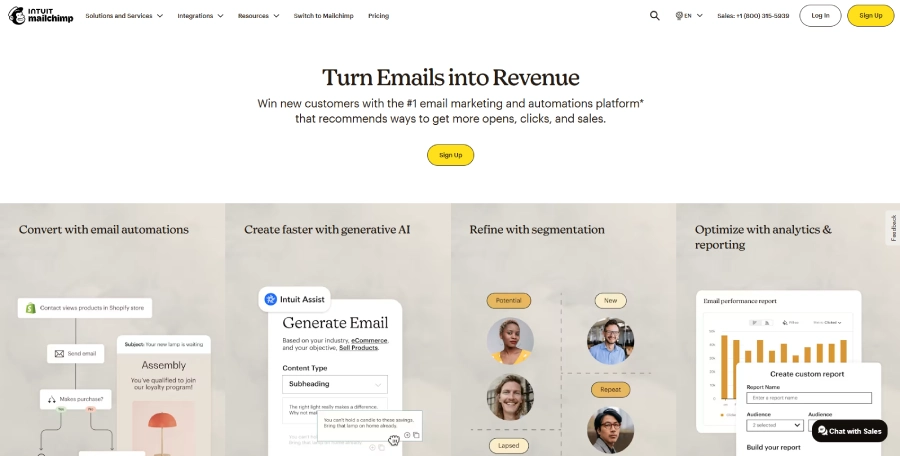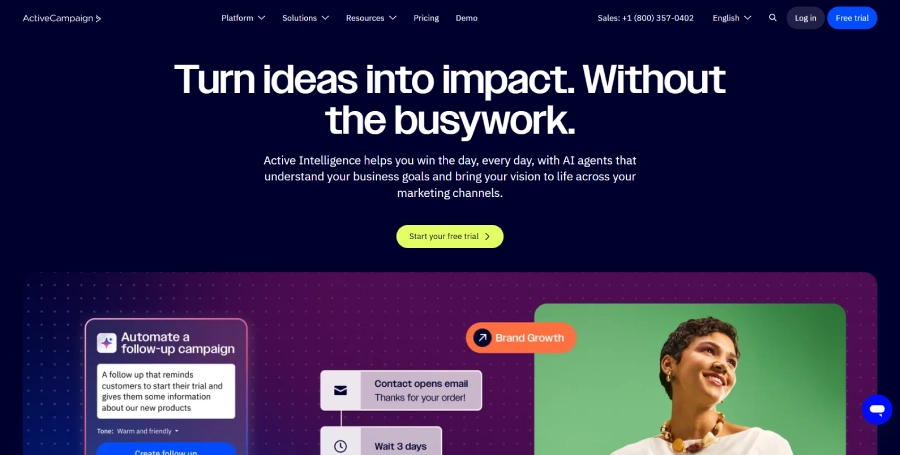Email marketing has always been a very successful technique till date to contact, engage and convert your target audience. You may start to improve the process by using free email automation tools and softwares for your marketing goals. In this post, we’ll look at the best 11 (1 added bonus) email marketing automation tools that you can use to take your email marketing to the next level.
What is Email Automation?
Email automation is the practice of using tools to send pre-written emails to a list of recipients automatically, without the need for human participation. It’s similar to having a computer programmer or robot that helps you rapidly and effectively send emails to many recipients.
To help you better grasp email automation, here is a straightforward example:
Suppose you’re a teacher and you want to inform all of your students and their parents every week through email about impending projects and exams. You can use email automation to send emails instead of manually typing and sending each one, which would take a lot of time.
You would first create a template email containing the crucial details for assignments and exams. Then, you would configure certain rules or triggers using an email automation service or piece of software. These triggers could be based on certain occasions or dates.
For instance, to remind everyone about the upcoming week, you could establish a trigger to send the email every Sunday night. The email automation tool will automatically send the template email to all of the kids and parents on your email list once you have set up the rules, saving you the time and effort of having to do it by hand every time.
Sending out newsletters, promotional emails, event invitations, or even customized emails to consumers are just a few of the many uses for email automation. With only a few clicks, you can quickly contact a huge number of individuals while also saving time and ensuring messaging consistency.
Overall, email automation is a powerful tool that facilitates communication by automating the email-sending process, making it simpler and more effective for companies, organizations, and people to keep in touch with their contacts.
List of Best Free Email Automation Tools
1. Mailchimp
Mailchimp is one of the most well-known and commonly used free email automation tools available. It is a paid service, though you can always use the free trial offered by the platform (No credit card required). It has a variety of functionalities, like email templates, dynamic list management, and automation processes. Mailchimp also offers comprehensive analytics, allowing you to follow the effectiveness of your campaigns and make data-driven choices.

What’s included in Mailchimp’s Free Plan?
Up to 2,000 subscribers and up to 10,000 emails per month.
- Basic email templates
- Marketing CRM
- Basic automation
- Reporting and analytics
Pros:
- User-friendly interface: Mailchimp is known for its intuitive and user-friendly interface, making it easy for users to navigate and manage their email marketing campaigns.
- Automation features: Mailchimp offers powerful automation features, allowing users to create customized automated workflows, such as welcome emails, abandoned cart reminders, and personalized drip campaigns.
- Extensive template library: Mailchimp provides a wide range of professionally designed email templates, making it simple for users to create visually appealing and engaging email campaigns.
- Integration capabilities: Mailchimp integrates seamlessly with various third-party platforms and tools, including e-commerce platforms, CRMs, and social media platforms, enabling users to streamline their marketing efforts.
- Robust analytics and reporting: Mailchimp offers detailed analytics and reporting features, providing insights into email open rates, click-through rates, subscriber engagement, and more, allowing users to track the performance of their campaigns effectively.
Cons:
- Limited functionality in the free plan: Mailchimp’s free plan has certain limitations, such as a cap on the number of subscribers and limited access to advanced features like automation and segmentation.
- Pricing structure: As your subscriber list grows, Mailchimp’s pricing can become more expensive compared to some other email marketing platforms, making it less cost-effective for larger businesses or high-volume senders.
- Complexity for advanced users: While Mailchimp is user-friendly for beginners, it may lack some advanced features that more experienced users may require, leading to limitations in customization and advanced automation capabilities.
- Limited customer support options: Mailchimp’s customer support is primarily provided through email and live chat, which may not be as responsive or comprehensive as phone support for urgent or complex issues.
2. HubSpot
HubSpot provides a range of marketing solutions, including free email automation software. With HubSpot, you can create automated email marketing campaigns that deliver personalized emails to your subscribers depending on their behavior and preferences. You can also use HubSpot’s drag-and-drop email editor to generate aesthetically stunning emails that are likely to capture your reader’s attention. Hubspot is slightly expensive compared to its rivals but the features and functionalities compensate for the price wisely. Don’t worry we have more options further.

What’s included in Hubspot’s Free Plan?
Hubspot is allowing users to send up to 2,000 emails per month with it’s free plan.
- Basic automation
- Contact management
- Lead capture forms
- Reporting and analytics
Pros:
- All-in-one marketing platform: HubSpot offers a comprehensive suite of marketing tools, including email marketing, CRM, social media management, content creation, and analytics, allowing users to manage their entire marketing strategy from one platform.
- Robust automation capabilities: HubSpot provides powerful automation features, enabling users to create sophisticated workflows and nurture leads with personalized email campaigns.
- Extensive reporting and analytics: HubSpot offers detailed analytics and reporting features, allowing users to track email performance, measure campaign success, and gain insights into their audience’s behavior.
- Contact management and segmentation: HubSpot’s CRM allows users to manage and segment their contacts effectively, helping them deliver targeted and personalized email content.
- Integration with other HubSpot tools: Users can take advantage of seamless integration with other HubSpot tools, such as their CMS and sales tools, creating a unified and streamlined marketing and sales process.
Cons:
- Learning curve: HubSpot’s extensive features and functionalities can have a steep learning curve, especially for users who are new to marketing automation platforms.
- Limited scalability: HubSpot’s free version has limitations on the number of contacts and emails, making it less suitable for businesses with larger audiences or high-volume email campaigns.
- Pricing: The paid plans of HubSpot can be relatively expensive, especially for small businesses or startups with limited budgets.
- Dependency on the HubSpot ecosystem: While HubSpot offers a wide range of tools, users may feel locked into the HubSpot ecosystem and find it challenging to integrate with external platforms.
- Customer support: Some users have reported mixed experiences with HubSpot’s customer support, citing delays in response times or difficulty in resolving issues.
3. ActiveCampaign
ActiveCampaign is a robust email marketing automation system that includes free email marketing, marketing automation, and CRM integration. You can use ActiveCampaign to create targeted campaigns that send personalized content to your audience based on their behavior, interests, and choices. The most interesting part is that all of this is offered at a very reasonable price that feels light to your pocket and boosts your business like a rocket.

What’s included in ActiveCampaign’s Free Plan?
ActiveCampaign’s free version allows users to send up to 500 emails per month.
- Basic automation
- Contact management
- Reporting and analytics
Pros:
- Advanced automation features: ActiveCampaign offers robust automation capabilities, allowing users to create highly personalized and sophisticated automated email campaigns based on customer behavior and triggers.
- Powerful segmentation and personalization: ActiveCampaign provides advanced segmentation options, enabling users to target specific segments of their audience with personalized content, resulting in higher engagement and conversion rates.
- CRM integration: ActiveCampaign seamlessly integrates with its CRM functionality, allowing users to manage contacts, track interactions, and gain a comprehensive view of their customers’ journey.
- Comprehensive email deliverability tools: ActiveCampaign includes features to help optimize email deliverability, such as automated list cleaning, bounce management, and engagement tracking, ensuring that emails reach the intended recipients’ inboxes.
- Extensive third-party integrations: ActiveCampaign offers a wide range of integrations with other tools and platforms, allowing users to connect their email marketing efforts with various third-party applications.
Cons:
- Learning curve: ActiveCampaign’s advanced features and functionalities can be complex, requiring a learning curve for users who are new to marketing automation platforms.
- Price for scaling: As user lists and email volume increase, ActiveCampaign’s pricing can become more expensive compared to some other email marketing platforms, making it less cost-effective for larger businesses or high-volume senders.
- Template limitations: Some users have reported that ActiveCampaign’s email template library could benefit from more diverse and modern design options.
- Customer support: While ActiveCampaign offers support through email and chat, some users have mentioned that response times can be slow during peak periods.
4. KIT (ConvertKit)
KIT (Formerly known as ConvertKit) is a FREE to use popular email marketing automation solution for bloggers, podcasters, and other content providers. KIT allows you to bisect your subscribers effortlessly and deliver personalized emails based on their interests and behavior. ConvertKit also includes a number of email marketing automation capabilities, such as email sequences and auto-responders.

What’s included in KIT’s Free Plan?
Kit’s free version includes access to their email marketing tools, allowing users to send unlimited emails to up to 10,000 subscribers.
- Visual automation editor
- Tag-based segmentation
- Reporting and analytics
Pros:
- User-friendly interface: ConvertKit is known for its simple and intuitive interface, making it easy for users, especially bloggers and creators, to set up and manage their email marketing campaigns.
- Tag-based system: ConvertKit utilizes a tag-based system for segmenting subscribers, allowing users to easily target specific groups with personalized content based on their interests and behaviors.
- Visual automation editor: ConvertKit offers a visual automation editor that allows users to create complex automated workflows visually, making it easier to design and implement sophisticated email sequences.
- Landing page and form builder: ConvertKit provides a built-in landing page and form builder, allowing users to create customizable opt-in forms and landing pages to grow their email list.
- Subscriber-centric approach: ConvertKit places a strong emphasis on building relationships with subscribers. It allows users to send personalized emails and track subscriber engagement, leading to better audience engagement and connection.
Cons:
- Limited customization options: Some users have noted that ConvertKit’s email templates and design options are relatively limited compared to other platforms, which may restrict the visual customization of email campaigns.
- Lack of advanced features: ConvertKit’s focus on simplicity means that it may lack some advanced features, such as A/B testing or advanced automation capabilities, which may be important for users with more complex marketing needs.
- Pricing scalability: As user lists grow, ConvertKit’s pricing can become more expensive compared to other email marketing platforms, making it less suitable for larger businesses or high-volume senders.
- Limited integrations: While ConvertKit offers integrations with popular tools and platforms, some users have mentioned that they would like to see a wider range of integrations available.
5. Brevo (Formerly – Sendinblue)
Sendinblue has recently re-positioned themselves as Brevo which is an all-in-one marketing platform with a variety of capabilities, including email marketing automation, Drag and drop editor, SMS and Whatsapp campaigns. Sendinblue allows you to design targeted campaigns that provide personalized information to your subscribers depending on their behavior and interests. Sendinblue also provides a number of automation capabilities, such as email sequences and autoresponders. It’s FREE plan offers upto 300 emails/day, which means it is one of the best platform to start your marketing journey.

What’s included in Brevo’s Free Plan?
Sendinblue’s (Brevo) free version allows users to send up to 300 emails per day to an unlimited number of subscribers.
- Basic automation
- Advanced segmentation
- Email templates Library
- Basic reporting and analytics
Pros:
- All-in-one marketing platform: Sendinblue offers a comprehensive suite of free email automation tools, including email marketing, SMS marketing, marketing automation, landing page creation, and more, allowing users to manage multiple aspects of their marketing campaigns from a single platform.
- Easy-to-use interface: Sendinblue provides a user-friendly interface that makes it accessible for users of all levels of experience to create and send professional email campaigns without technical expertise.
- Advanced automation capabilities: Sendinblue offers advanced automation features, allowing users to create automated workflows based on customer behavior, triggers, and segmentation, enabling personalized and timely communication with subscribers.
- Transactional email and SMS: Sendinblue provides the ability to send transactional emails and SMS messages, making it suitable for businesses that require automated notifications, order confirmations, or other transactional messages.
- Robust reporting and analytics: Sendinblue offers detailed reporting and analytics, allowing users to track email campaign performance, delivery rates, open rates, click-through rates, and other key metrics to measure the effectiveness of their campaigns
Cons:
- Limitations on free version: The free version of Sendinblue has certain limitations, such as daily email send limits, limited access to templates, and advanced features available only in paid plans, which may be restrictive for businesses with larger subscriber lists or more complex marketing needs.
- Learning curve for advanced features: Some users have mentioned that utilizing advanced features and automation capabilities of Sendinblue may require a learning curve and technical understanding.
- Limited third-party integrations: While Sendinblue offers integrations with popular platforms, the number of integrations available may be more limited compared to some other email marketing platforms.
- Basic template customization options: Users have reported that the customization options for email templates in Sendinblue can be somewhat limited compared to other platforms, which may affect the ability to create highly personalized and unique designs.
6. Sender.net
Sender.net is a versatile and comprehensive email marketing platform that empowers businesses and individuals to connect with their audience effectively. With its user-friendly interface and powerful features, Sender.net enables users to create, send, and track personalized email campaigns with ease. Whether you’re a small business owner or a seasoned marketer, Sender.net offers a wide range of free email marketing autiomation tools and resources to optimize your email marketing efforts. From customizable templates and automation workflows to advanced analytics and segmentation options, Sender.net provides the necessary tools to engage subscribers, nurture leads, and drive conversions. With Sender.net, you can harness the power of email marketing automation to build strong relationships and achieve your business goals.

What’s included in Sender.net’s Free Plan?
Sender.net’s free version allows users to send up to 15,000 emails per month to up to 2,500 subscribers.
- Basic automation
- Advanced segmentation
- List Management
- Email templates Library
- Basic reporting and analytics
Pros:
- User-friendly interface: Sender.net offers a user-friendly interface that makes it easy for users to create, send, and automate email campaigns without technical expertise.
- Email automation: Sender.net provides robust email automation features, allowing users to create personalized and targeted email workflows based on customer behavior, triggers, and segmentation.
- Advanced reporting and analytics: Sender.net offers detailed reporting and analytics, providing users with insights into email performance, open rates, click-through rates, conversions, and more, helping to optimize campaign effectiveness.
- Landing page builder: Sender.net includes a built-in landing page builder, allowing users to create custom landing pages to capture leads and promote their offers without the need for additional tools.
- Customer support: Sender.net offers responsive customer support, including email and chat support, to assist users with any questions or issues they may encounter.
Cons:
- Limited scalability: The free version of Sender.net has limitations on the number of subscribers and emails, making it less suitable for businesses with larger audiences or high-volume email campaigns.
- Template customization options: Some users have mentioned that the customization options for email templates in Sender.net may be more limited compared to other platforms, which can impact the ability to create highly personalized designs.
- Advanced automation limitations: While Sender.net offers automation capabilities, some users have reported that the advanced automation features and workflows may have certain limitations compared to more robust marketing automation platforms.
- Third-party integrations: While Sender.net integrates with popular platforms, the number of integrations may be more limited compared to some other email marketing platforms.
- Advanced features in paid plans: Some advanced features, such as A/B testing or certain automation workflows, may only be available in higher-tier paid plans, which may require an upgrade for users with specific needs.
Conclusion
Free Email automation tools may help you save time, enhance engagement, and drive conversions from your leads and audience. You may take your email marketing to the next level and obtain even greater results by utilizing one of the 6 tools described in this article. Whether you’re a blogger, an eCommerce firm, or a marketing agency.

